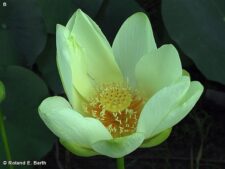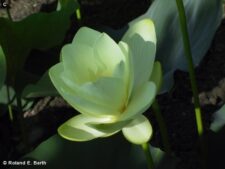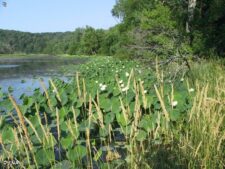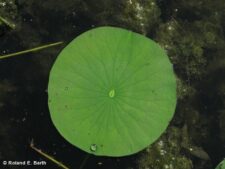
AMERICAN LOTUS
Nelumbo lutea
LOTUS FAMILY (Nelumbonaceae)
 Identification
Identification
- Flowering time - July, August
- Locally common in the shallow water of the Great Marsh at Fontenelle Forest
- Large, fragrant flower on long stalk rising above water
- Large, round, disk shaped leaves
- Funnel shaped pod containing many acorn-like seeds
This native aquatic perennial has large, white to pale yellow, fragrant flowers on long stalks above the water (A). The flowers bloom in June and July (A,B,C). The leaves are disk-like, flat on the water (F), or on long stalks above the water (A). The fruit, resembling acorns in a nodding, funnel-shaped pod (D), ripens by early August.
This Lotus grows in shallow water. At Fontenelle Forest it is common in the Great Marsh (E). Flowering occurs in July and August.
This plant was an important and highly prized source of food for the Omaha and Ponca. They stomped through the mud to search for the tubers with their feet. Then they used a hooked stick to pull them out. The tubers look like yellow bananas end-to-end. They were either cooked or preserved for the winter by drying after they had been peeled and sliced. The nut-like seeds were cracked and freed from their shells, then cooked in a soup with meat. Because of the heavy collecting by Native Americans for consumption, this native plant was reported as quite rare in our area by the 1850s. It had been recorded nearby as early as 1811 by the Bradbury Expedition. The current population probably stems from seed planted by Dr. Harold Gifford and his father in the 1920s. This Lotus is also known as Water Chinkapin.
The content of NatureSearch is provided by dedicated volunteer Naturalists of Fontenelle Forest who strive to provide the most accurate information available. Contributors of the images retain their copyrights. The point of contact for this page is: Roland Barth.





